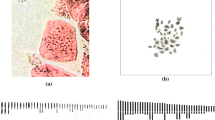Abstract
Detailed karyological analyses have been made of the five biotypes ofPennisetum pedicellatum Trin. These biotypes not only differ in some morphological traits but also in their chromosomal characteristics. Biotype-B with 2n = 48 chromosomes shows constancy, while in the other four 2n = 36 and 64 are found to be “floating”. Other numerical variations include 2n = 42 and 18 chromosomes. Minute karyological differences are not only noted amongst the biotypes, but also there are variations in the complements within a biotype. Such variations are presumed to be buffered through the apomictic mode of reproduction. From the morphological and cytological studies, the possibility of separation of biotype-B from the complex in future has been envisaged.
Similar content being viewed by others
References
Al-Fakhry, A. K., Sarvella, P., Grogan, C. O.: Somatic chromosomes of belala. - J. Hered.55: 57–60, 1064.
Bogdan, A. Y.: Tropical Pastures and Forage Plants. - Longman Publ., New York 1977.
Bor, N. L.: The Grasses of Burma, Ceylon, India and Pakistan. - Pergamon Press, London 1960.
Carnahan, H. L., Hill, H. D.: Cytology and genetics of forage grasses. - Bot. Rev.27: 1 -162, 1961.
Chandola, R. P., Jain, S. N.: Karyomorphological studies inPennisetum typhoides L. - Cytologia35: 181–196, 1970.
Chase, A., Niles, C. D.: Index to Grass Species. Vol. 3. - G. K. Hall and Company; Boston 1962.
Chatterji, A. K., Das, A. P.: Cytomorphological studies of the biotypes ofPennisetum pedicellatum Trin. -Caryologia32: 5–14, 1979.
Chatterji, A. K., Pillai, G. K.: Apomixis inPennisetum pedicellatum Trin. - Sci. Cult.36: 662–669, 1970.
Chatterji, A. K., Reddy, B. M.: Cytology and breeding behaviour ofPennisetum pedicellatum Trin. - In: 2nd All Indian Congress of Cytology and Genetics (Abstract). Pp. 25–26. Udaipur 1975.
Gill, B. S., Gupta, A. K.: Study of karyotypemorphology ofPennisetum typhoides Stapf and Hubb. - J. Res. Punjab Agr. Univ., Ludhiana3: 118–121, 1966.
Gilldenhuys, P., Brix, K.: Cytogenetic evidence of relationship between the × = 7 and × = 9 groupsof Pennisetum species. - Züchter31: 125–127, 1961.
Harlan, J. R.: Evolutionary dynamics of plant domestication. - Jap. J. Genet.14: 337–343, 1969.
Hrishi, N. J.: Studies on the cytogenetics of six species ofPennisetum and their comparative morphology and anatomy. -Genetica26: 282–356, 1952.
Joshi, A. B., Patil, B. D., Machanda, P. L.: Chromosome number in some grasses. - Curr. Sci.28: 254–255, 1959.
Narayan, K. N.: Cytogenetic studies of apomixis inPennisetum. - Unpublished Ph. D. Thesis. Univ. Calif., U.S.A. 1951.
Nath, J., Swaminathan, M. S.: Chromosome number in some grasses. - Ind. J. Genet.17: 102, 1957.
Pantulu, J. V.: A case of chromosomal interchange in pearl millet. - Curr. Sci.17: 497–498, 1958.
Powell, J. B., Burton, G. W.: Chromosome interchanges of spontaneous origin in Pearl millet,Pennisetum typhoides. - Crop Sci.9: 252–253, 1969.
Sharma, A. K.: A new concept of a means of speciation in plants. - Caryologia9: 93–130, 1956.
Sharma, A. K., De, D. N.: Cytology of some of the millets. - Caryologia9: 294–308, 1956.
Swaminathan, M. S., Nath, J.: Two new basic chromosome numbers in the genusPennisetum. - Nature178:1241–1242, 1956.
Whyte, R. O.: The Grassland and Fodder Resources of India (Revised edition). - I.C.A.R., New Delhi 1964.
Author information
Authors and Affiliations
Rights and permissions
About this article
Cite this article
Chatterji, A.K., Sahu, N. Biotypic differences in the karyology ofPennisetum pedicellatum Trin. Biol Plant 24, 13–19 (1982). https://doi.org/10.1007/BF02898476
Received:
Accepted:
Issue Date:
DOI: https://doi.org/10.1007/BF02898476




